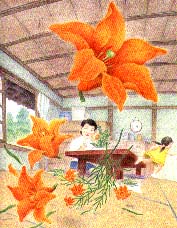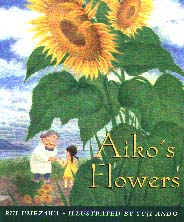|
________________
CM . . . .
Volume VI Number 18 . . . . May 12, 2000
excerpt: "Why must I learn ikebana ?"  Ikebana is the traditional art of Japanese flower arranging. In Aiko's Flowers, the reader
experiences both the frustration Aiko feels in learning a difficult traditional art and her lack of
understanding of the purpose of learning this tradition. Young readers can identify with Aiko's
sentiment that ikebana is a chore and that she would rather be playing video games with her
brother. After Aiko meets an old woman in a field of sunflowers, she begins to see the world
around her differently. She returns home with a new appreciation of tradition and a willingness to
learn what her mother and grandmother had learned before her, ikebana.
Ikebana is the traditional art of Japanese flower arranging. In Aiko's Flowers, the reader
experiences both the frustration Aiko feels in learning a difficult traditional art and her lack of
understanding of the purpose of learning this tradition. Young readers can identify with Aiko's
sentiment that ikebana is a chore and that she would rather be playing video games with her
brother. After Aiko meets an old woman in a field of sunflowers, she begins to see the world
around her differently. She returns home with a new appreciation of tradition and a willingness to
learn what her mother and grandmother had learned before her, ikebana.Yuji Ando, a Japanese award-winning artist and cartoonist, provides soft toned, full page illustrations to support the telling of Aiko's story. The characters are drawn in an almost cartoon-like style, at times seemingly out of proportion. Especially in the case of the portrayal of the old woman, this technique might distract attention from the story. However, because interpretation of illustrative style varies with individuals, this becomes a personal preference. Japanese-Canadian author Rui Umezawa creates a story, set in Japan, that has a universal theme for all readers - tradition. In an era of constant change, understanding of the value of tradition and sharing it from one generation to another can be difficult. Aiko's Flowers illustrates the realization of the gift of tradition by a child. The book also exposes young readers to the purpose of ancient art form of ikebana. The book's afterword provides further information on the origins of ikebana and its current popularity. Literature, such as Aiko's Flowers, provides young readers with an opportunity to examine and study different cultures while enjoying a good story. Recommended. Janice Foster is a teacher-librarian in Fort Garry School Division in Winnipeg, MB.
To comment on this title or this review, send mail to cm@umanitoba.ca.
Copyright © the Manitoba Library Association.
Reproduction for personal use is permitted only if this copyright notice
is maintained. Any other reproduction is prohibited without
permission.
Published by
TABLE OF CONTENTS FOR THIS ISSUE - May 12, 2000.
AUTHORS |
TITLES |
MEDIA REVIEWS |
PROFILES |
BACK ISSUES |
SEARCH |
CMARCHIVE |
HOME
|
